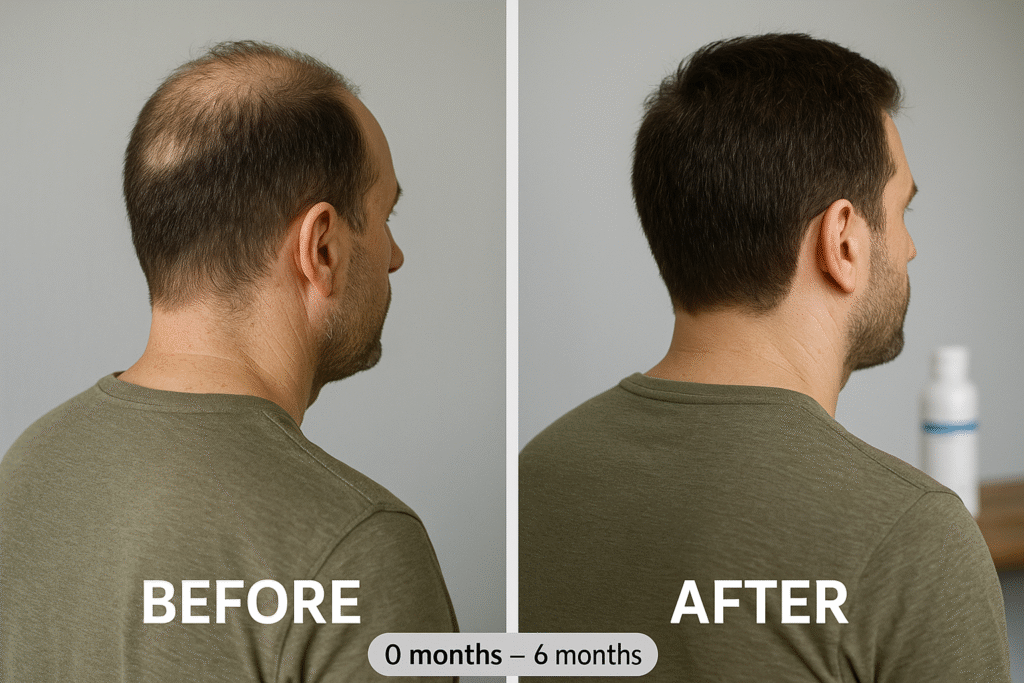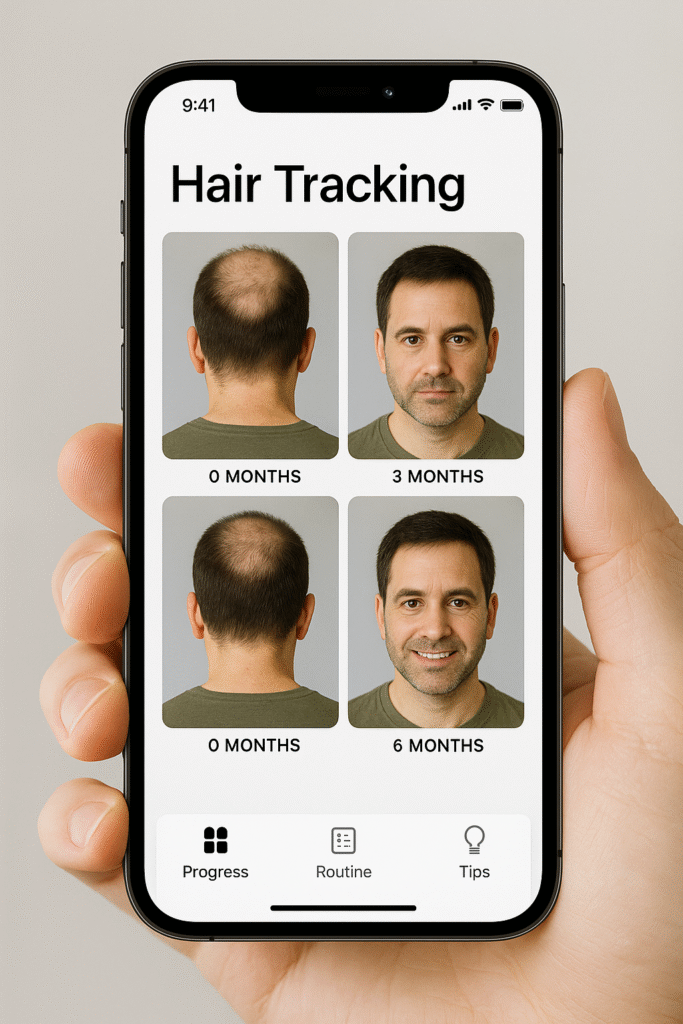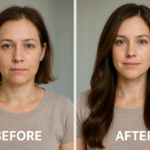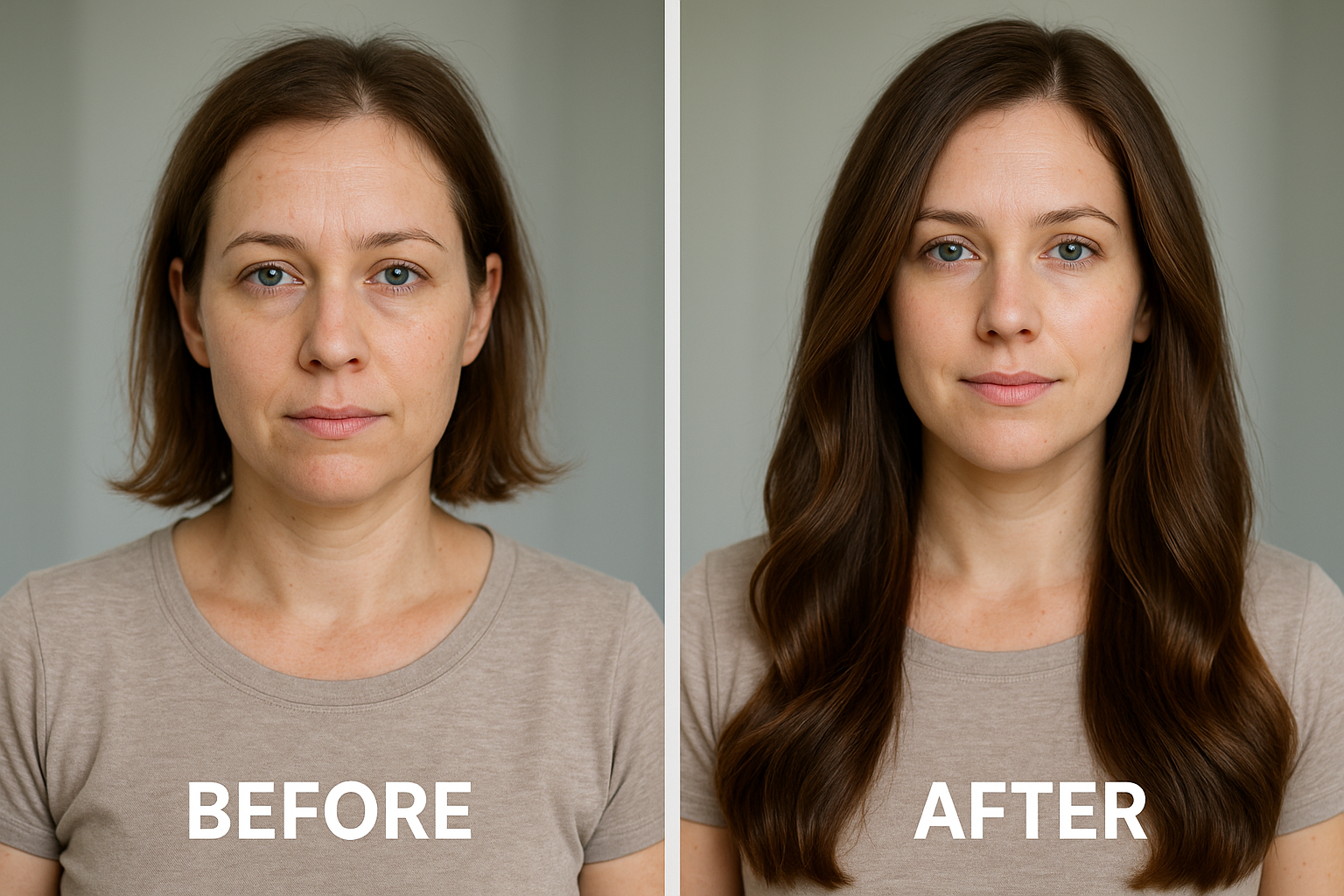Let’s be real, watching hair grow is like watching paint dry, except the paint might dry faster. I’ve been there, staring at my reflection every morning, wondering if those baby hairs are actually sprouting or if I’m just seeing things. But here’s the thing: tracking your hair growth progress isn’t just about obsessive mirror-gazing (though we’ve all done it). It’s about creating a systematic approach that shows you whether your hair growth journey is heading in the right direction.
Whether you’re bouncing back from a questionable haircut, dealing with hair loss, or simply trying to achieve those Rapunzel-length locks you’ve been dreaming about, having a solid hair growth tracking system is your secret weapon. Trust me, your future self will thank you for starting this documentation journey today.
Why Track Your Hair Growth Progress?
Before we dive into the how-to, let’s talk about the why. I used to think tracking hair growth was just vanity until I realized it’s science meeting self-care. When you monitor your progress consistently, you’re not just feeding your curiosity; you’re gathering valuable data about what works for your unique hair situation.
Think about it: without proper tracking, how would you know if that expensive serum is worth its weight in gold, or if your new vitamin regimen is doing anything beyond emptying your wallet? Hair growth monitoring gives you the power to make informed decisions about your hair care routine, and honestly, that’s pretty empowering.

The Science Behind Hair Growth: What You Need to Know
Here’s a fun fact that might surprise you: the average rate of hair growth per month is about half an inch, or roughly 6 inches per year. But—and this is a big BUT—this rate varies dramatically from person to person. Some lucky folks might see up to 8 inches annually, while others might clock in at a modest 4 inches.
Your hair growth rate depends on several factors:
- Genetics (thanks, parents!)
- Age (unfortunately, things slow down as we get older)
- Hormonal fluctuations
- Overall health and nutrition
- Seasonal changes (yes, hair grows faster in summer!)
- Stress levels
Understanding these variables helps explain why consistent tracking is so crucial. What looks like slow progress might be perfectly normal for your hair type and life circumstances.
Essential Tools for Hair Growth Measurement
Let’s talk tools—because measuring hair growth isn’t just about eyeballing it in the mirror. You need the right equipment to get accurate, consistent results.
Digital Hair Growth Apps
The tech world has blessed us with some seriously impressive hair growth apps that take the guesswork out of tracking. Here are my top picks:
Hairly App stands out as the gold standard for digital tools for hair growth monitoring. This AI-powered marvel doesn’t just store your photos—it analyzes them, comparing hair density, length, and even scalp health over time. It’s like having a hair scientist in your pocket.
MyHair.ai takes things up a notch with advanced scalp analysis. The app provides personalized recommendations based on your progress, making it feel like you have a personal hair consultant available 24/7.
For those who love data (and I mean love data), the GroTrack Hair Monitoring System combines a physical measuring device with app integration. It’s the Ferrari of hair tracking tools—sophisticated, precise, and worth the investment if you’re serious about monitoring every millimeter of growth.

Traditional Measurement Tools
Sometimes old school is the best school. A simple hair growth measurement ruler—preferably one that’s flexible and gentle on your scalp—can be incredibly effective. I recommend keeping one dedicated specifically for hair measurements to ensure consistency.
The Hair Growth Progress T-shirt is honestly genius. It features printed measurement lines that make taking consistent progress photos foolproof. No more trying to remember which bathroom tile to line up with—just slip on the shirt and snap away.
How to Take Consistent Hair Progress Photos
Photography might seem straightforward, but when it comes to hair progress photos, consistency is everything. I learned this the hard way after taking three months of photos in different lighting conditions and having to start over.
Setting Up Your Photo Station
Create a dedicated space for your monthly hair photos. Choose a spot with:
- Consistent natural lighting (near a window is ideal)
- A neutral background (white or light-colored walls work best)
- The same distance from the wall each time
Photo Angles That Matter
You’ll want to capture multiple angles to get the full picture:
- Back view (straight down the back)
- Side profiles (both left and right)
- Top view (showing the crown and part line)
- Close-ups of specific areas you’re monitoring
Pro tip: Set a monthly reminder on your phone and take all your photos on the same day each month, preferably at the same time of day. Your hair’s appearance can change throughout the day due to styling, humidity, and even how you slept, so consistency here is key.
Creating Your Hair Growth Journal
A hair growth journal is more than just a photo album—it’s your personal hair detective notebook. Here’s what to include:
Essential Tracking Elements
Date and Time: Always note when you’re taking measurements or photos.
Length Measurements: Measure from the same starting point each time. I recommend measuring from the crown to the longest point, and also noting the length at different sections (sides, back, etc.).
Density Observations: Note any changes in thickness, particularly around your hairline or any areas of previous thinning.
Product Usage: Log what you’re using, when you started, and any changes you make to your routine.
Lifestyle Factors: Did you start a new diet? Change medications? Experience unusual stress? These details matter more than you might think.
Subjective Feelings: How does your hair feel? More brittle? Softer? Sometimes, the qualitative data is just as important as the measurements.
Digital vs. Physical Journals
The Curly Proverbz Hair Growth Challenge Planner offers a beautifully designed physical option that many find more engaging than digital alternatives. There’s something satisfying about physically writing down your progress—it makes the journey feel more real and intentional.
However, digital journals offer advantages like automatic backups, easy photo integration, and the ability to set reminders. Choose what feels most sustainable for your lifestyle.
Advanced Hair Growth Monitoring Techniques
Ready to level up your tracking game? Let’s talk about some more sophisticated approaches.
Professional-Grade Tools for Home Use
The Philips Digital Hair Analyzer brings salon-level analysis to your bathroom. This digital microscope captures detailed images of your scalp and individual follicles, allowing you to monitor not just length but also hair health at the follicular level.
The TrichoScope Digital Microscope connects directly to your smartphone, making it easy to build a comprehensive visual database of your scalp health over time. It’s particularly valuable if you’re dealing with hair thinning or recovering from hair loss.
Monitoring Hair Density and Scalp Coverage
Hair density tracking requires a more nuanced approach than simple length measurement. Here’s what to watch for:
- Hairline changes: Take close-up photos of your hairline from the same angle each month
- Part width: Notice if your part is getting wider or narrower
- Crown coverage: The top of your head often shows density changes first
- Overall volume: How does your hair look when styled the same way each month?
Recognizing Healthy Growth vs. Breakage
This is where many people get tripped up. What signs indicate healthy hair growth versus breakage? Learning to distinguish between the two is crucial for accurate progress assessment.
Signs of Healthy Growth
- Consistent length increase across all measured areas
- Strong, flexible hair that doesn’t break easily when gently tugged
- Healthy scalp condition (no excessive itching, flaking, or irritation)
- Even growth patterns without significant weak spots
- Tapered ends that look healthy rather than split or frayed
Red Flags for Breakage
- Length that seems to plateau despite time passing
- Excessive hair in your brush or shower drain
- Brittle texture that snaps easily
- Split ends are appearing faster than you can trim them
- Uneven length where some sections seem shorter than others
Tracking Hair Regrowth After Hair Loss
How do I track hair regrowth after hair loss or medical treatment? This situation requires a modified approach that’s both more gentle and more detailed.
Special Considerations for Post-Treatment Growth
If you’re tracking regrowth after chemotherapy, alopecia, or other medical hair loss, your timeline and expectations need adjustment. Initial regrowth often comes in with a different texture or color than your original hair—document these changes as they’re part of your unique journey.
Focus on:
- Scalp health, first and foremost
- New growth patterns (hair might grow back differently)
- Texture changes throughout the regrowth process
- Color variations as hair matures
Celebrating Small Wins
When you’re starting from zero (or near-zero), every millimeter counts. Consider weekly photos during the early stages, then transition to monthly once you have a few inches of growth.
Lifestyle Factors That Affect Your Progress
What lifestyle factors can affect my hair growth progress? More than you might realize. Your hair is a living record of your overall health, and tracking these factors alongside your growth measurements can reveal fascinating patterns.
Nutrition and Hair Growth
Your hair follicles are among the most active cells in your body, which means they’re also among the hungriest. Deficiencies in iron, protein, biotin, or vitamin D can significantly impact growth rates. Note any dietary changes or supplement additions in your journal.
Stress and Sleep Patterns
Chronic stress can shift your hair follicles into a resting phase, slowing growth dramatically. Similarly, poor sleep disrupts the hormone cycles that support healthy hair growth. Track your stress levels and sleep quality—you might be surprised by the correlations you discover.
Seasonal Variations
Don’t panic if your growth seems to slow in winter—this is completely normal. Hair grows fastest in summer and can slow by up to 20% during colder months. Factor this into your expectations and tracking timeline.
Supporting Products That Make a Difference
Let’s talk about the products that can genuinely support your hair growth journey. Not every expensive serum lives up to its promises, but some earn their keep.
Scientifically-Backed Growth Stimulators
The HairMax LaserBand 82 represents the gold standard in at-home laser therapy. FDA-cleared for both men and women, it uses low-level laser therapy to stimulate follicles at the cellular level. If you invest in one growth-supporting device, this should be it.
The iRestore Professional Hair Growth System offers a hands-free alternative with its helmet design, perfect for multitasking during your treatment sessions.
Supplement Support
Viviscal Hair Growth Supplements consistently rank as the most recommended by dermatologists and trichologists. The marine collagen complex has solid research backing its effectiveness.
Nutrafol Hair Wellness Supplements take a more comprehensive approach, addressing multiple factors that influence hair growth, including stress, hormones, and nutrition.
Bosley MD: This is by far my favorite and I have had clients who take them. If you want to get this, it is better to ask if your hairstyle can help you get it or get it directly from their website.
Topical Treatments
Vegamour GRO Hair Serum has gained a cult following for good reason—the plant-based formula is gentle enough for sensitive scalps while still delivering noticeable results.
For those dealing with significant hair concerns, Nioxin Scalp & Hair Leave-In Treatment creates an optimal scalp environment for growth while strengthening existing hair.

Common Tracking Mistakes to Avoid
After years of monitoring my hair growth and helping others with theirs, I’ve seen these mistakes repeatedly:
The Impatience Trap
Checking progress weekly instead of monthly leads to disappointment and skewed perception. Hair growth is slow—embrace it.
Inconsistent Conditions
Taking photos in different lighting, with different styling, or at different times creates unreliable data. Consistency is your best friend here.
Ignoring External Factors
Not noting changes in products, health, stress, or season makes it impossible to understand what’s affecting your growth rate.
All-or-Nothing Mentality
Missing a month of tracking doesn’t mean you should give up entirely. Just restart and keep going—some data is infinitely better than no data.
Creating Your Personalized Tracking System
Now let’s put it all together into a system that works for your lifestyle and goals.
Monthly Tracking Checklist
Create a checklist for your monthly tracking session:
- Take progress photos in consistent lighting
- Measure length from the crown to the longest point
- Measure specific sections if monitoring uneven growth
- Assess density at the hairline and crown
- Note any changes in texture or appearance
- Update hair growth journal with products and lifestyle factors
- Review and compare with previous months
Quarterly Deep Dives
Every three months, do a more comprehensive analysis:
- Compare photos from three months ago
- Calculate your growth rate
- Assess whether your current routine is working
- Consider adjustments to products or techniques
- Set goals for the next quarter
Technology Tools for Advanced Tracking
Hair Growth Rate Calculators
Several online calculators can help you determine if your growth rate is within normal ranges based on your measurements. While these aren’t a substitute for professional assessment, they provide helpful context for your progress.
Progress Tracking Apps Integration
Many of the modern hair growth apps now integrate with health tracking platforms, allowing you to correlate hair growth with other health metrics like sleep, exercise, and nutrition. This holistic approach often reveals surprising connections.
When to Seek Professional Help
How can I tell if my hair growth treatment is working? Sometimes the answer requires professional evaluation. Consider consulting a dermatologist or trichologist if:
- You see no growth after 6+ months of consistent tracking
- Hair loss appears to be accelerating
- You notice sudden changes in hair texture or scalp health
- Growth is extremely uneven or patchy
- You’re experiencing other symptoms alongside hair changes
Staying Motivated During Your Journey
Hair growth tracking is a marathon, not a sprint. Here are strategies to maintain momentum:
Celebrate Small Victories
Every quarter-inch is progress worth acknowledging. Consider treating yourself when you hit growth milestones—maybe a new hair accessory or a professional trim to keep ends healthy.
Connect with Others
Join hair growth communities online where you can share progress and get support during slower growth periods. Sometimes seeing others’ journeys helps normalize your own experience.
Focus on Hair Health, Not Just Length
Healthy hair is beautiful hair, regardless of length. Sometimes, the most dramatic improvements are in shine, texture, and overall appearance rather than pure length gains.
Building Long-Term Hair Growth Success
Successful hair growth progress tracking becomes a lifestyle rather than a temporary project. The habits you build around monitoring and caring for your hair will serve you well beyond reaching your initial length goals.
Maintenance Mode
Once you reach your desired length, tracking doesn’t stop—it evolves. You’ll shift focus from growth to maintenance, monitoring for any changes that might indicate health issues or the need for routine adjustments.
Knowledge Transfer
Document what works for your hair type and lifestyle. This personal database becomes invaluable if you ever need to restart your growth journey or help family members with similar hair concerns.
Conclusion: Your Hair Growth Journey Starts Now
Tracking your hair growth progress isn’t just about documenting length—it’s about understanding your hair, your body, and what makes both thrive. Whether you choose a simple journal and measuring tape or invest in high-tech analysis tools, the key is consistency and patience.
Remember, every hair journey is unique. Your growth rate, optimal products, and best tracking methods might be completely different from someone else’s, and that’s perfectly normal. The goal isn’t to match someone else’s timeline—it’s to understand and optimize your own.
Start small if you need to. Even basic monthly photos and length measurements provide valuable data over time. As you get comfortable with the routine, you can always add more sophisticated tracking elements.
Your hair growth journey is ultimately about more than just longer hair—it’s about understanding your body, building healthy habits, and celebrating the small victories along the way. So grab your measuring tape, set up that photo spot, and start documenting. Six months from now, you’ll be amazed at both your progress and your increased understanding of what makes your hair thrive.
The best time to start tracking your hair growth was six months ago. The second-best time is right now. Your future self—with gorgeous, healthy hair—is counting on you to take that first measurement today.
What tracking method will you start with? Share your hair growth goals and let’s celebrate this journey together!
Ready to begin your hair growth tracking journey? Start with one simple method today—whether it’s downloading a tracking app, taking your first progress photo, or measuring your current length. Remember, the most sophisticated tracking system is the one you’ll use consistently.
Disclaimer: This article is for informational purposes only and is not intended as medical advice. Individual hair growth rates vary significantly based on genetics, health conditions, and other factors. If you’re experiencing sudden hair loss, significant changes in hair texture, or other concerning symptoms, please consult with a dermatologist or healthcare professional. Results from hair growth products and treatments may vary, and it’s important to patch test any new products before regular use.
Link to the post contain affiliate link, that support our blog when you purchase an item through the link









Your article is a well-structured, engaging, and thorough guide that balances practical advice with a relatable tone, making it both informative and enjoyable to read. It effectively covers everything from beginner tips to advanced tracking tools while emphasizing consistency and self-awareness. The blend of personal experience, scientific context, and actionable strategies adds credibility and depth, and your inclusion of both digital and traditional methods caters to a wide range of readers. To enhance it further, consider tightening repetitive sections, adding a visual tracker or sample chart, and incorporating a stronger call-to-action at the end to prompt immediate engagement.
Keep up the good work!
Thank you very much, S.J., for the advice.
Hi, it’s so refreshing to see a practical and relatable approach to tracking hair growth. I’ve tried countless hair serums and supplements over the years, and I often found myself wondering, “Is this actually working?” This guide has given me the tools and confidence to document my progress properly. The idea of using a Hair Growth Progress T-shirt is genius—I can’t wait to try it out! I also appreciate the emphasis on understanding individual growth rates and the science behind it. It’s a great reminder that patience and consistency are key. Thanks for sharing such valuable insights!